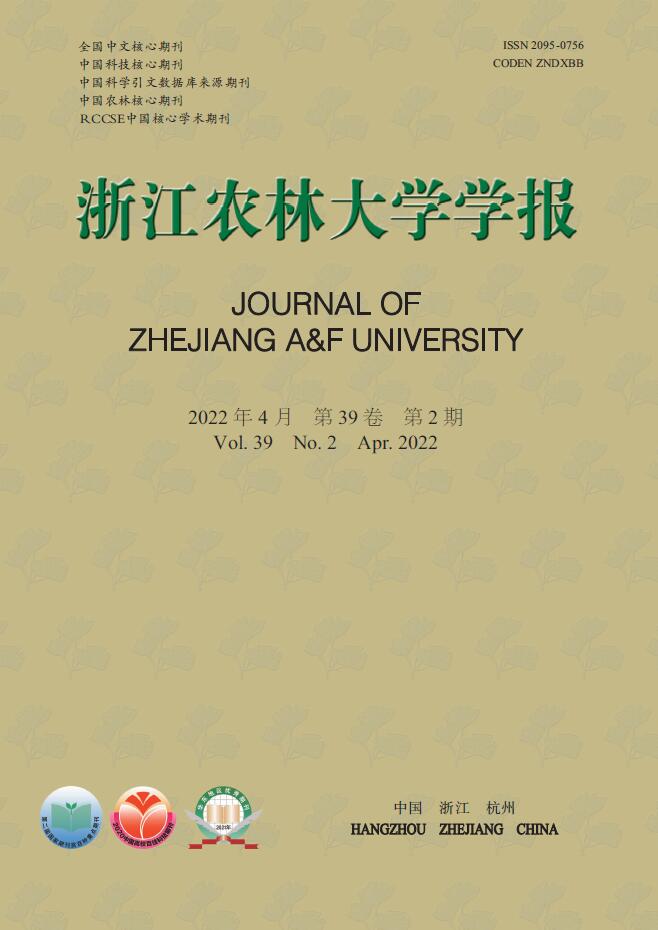-
随着环境保护要求的不断提高,环保型木材防腐剂越来越受到重视,此类防腐剂多以高效低毒的有机农药为主成分,配合其他助剂制备成有机型或水基型防腐剂[1-2]。三唑类杀菌剂,如丙环唑、戊唑醇、环丙唑醇、氟环唑和苯醚甲环唑等,既可以单独使用,又可以与铜制剂复配[3-4],是目前常用的木材防腐剂;这些三唑类杀菌剂杀菌谱不尽相同,作用机制也有所差异,应用较广泛的是丙环唑和戊唑醇[5-6]。常见的木材防霉剂有异噻唑啉酮类如卡松、1,2-苯并异噻唑-3-酮(BIT)、4,5-二氯-2-正辛基-3-异噻唑啉酮(DCOI)等,有机碘类如碘丙炔醇丁基氨甲酸酯(IPBC),三唑类等[7],杀菌谱也不尽相同;常用的仓储水果防霉剂如溴菌腈和抑霉唑[8-9],防霉活性较高,但较少应用于木材防霉。菊酯类杀虫剂是常见的防治白蚁的药剂,具有用量少、成本较低、废弃物易回收、环境相对友好等优点;高效氯氟氰菊酯在菊酯类杀虫剂中活性较高、稳定性较强、耐雨水冲刷性能较好。因含有大量羟基等亲水基团[10],木材变色、发霉、腐朽、变形等问题频发,品质降低[11-13],常用亚麻油、桐油、豆油、核桃油等含甘油三脂肪酸酯的植物油[14]和沥青、石蜡等含长链烷烃的矿物油用作木材防水;现代工业多将植物油与动植物蜡等复配成木蜡油[15],用作木材的表面防水处理剂。如马红霞等[16]使用56号石蜡制备木材防水剂,当石蜡质量浓度为5%时,防水效率可达54%;由此可见,石蜡可作为良好的木材防水剂。液体石蜡是经原油分馏得到的无色无味的液态烃类混合物,室温下为液态,用作防水剂时可省去加热融化环节,节约了能源和时间。木材在使用过程中需要多重保护,如防腐、防霉、防虫和防水等,存在工序繁琐、成本高昂等问题,为满足木材不同生物危害防治需要,本研究拟制备一种同时具有防腐、防霉、防虫和防水多项功能的水基型有机木材保护复合制剂,通过室内抑菌圈法筛选不同杀菌剂的抑菌活性,从中挑选活性较好、杀菌谱互补的防腐成分与防霉成分进行复配,并筛选两者的最佳配比;将其与杀虫成分和防水成分复配,制备成可以兑水自动乳化的乳油制剂。制备的复合制剂稳定性好,兼具防水、防腐、防霉、防白蚁等性能,同时处理工序简单,可达到常规生物危害防治要求的目的,为木材保护提供参考。
-
杀菌剂包括氟环唑(FCZ)、戊唑醇(TEB)、丙环唑(PPZ)、苯醚甲环唑(DCZ)、碘丙炔醇丁基氨甲酸酯(IPBC)、溴菌腈(BMN)、抑霉唑(IMZ)。杀虫剂为高效氯氟氰菊酯(CLT)。防水剂为液体石蜡(化妆品级)。以上试剂购自上海麦克林生化科技有限公司。
-
木材腐朽菌有褐腐菌密粘褶菌Gloeophyllun trabeum、白腐菌彩绒革盖菌Coriolus versicolor。木材混合霉菌有黑曲霉Aspergillus sp.、木霉Trichoderma sp.、青霉Penicillium sp.。木材变色菌可可球二孢Botryodiplodia theobromae。所有菌株均为实验室保存的生物测试标准用菌株。
测试树种为辐射松Pinus radiata。
-
预实验通过满细胞法确定辐射松边材吸液(水)量为750~850 kg·m−3;根据三唑类药剂防腐有效载药量(200.0~400.0 g·m−3)[17],换算药剂质量浓度为150.0~300.0 mg·L−1,确定试验用药质量浓度为200.0 mg·L−1。
-
通过室内抑菌效果普筛挑选出效果较好且杀菌谱互补的杀菌剂作为防腐和防霉成分。将挑选出的防腐和防霉成分按照不同配比混合进行复配,再次测试室内抑菌效果,确定效果较好的复配比例作为药剂配伍。
-
参照《中华人民共和国药典》的“抗生素微生物检定法”测试抑菌圈。将5种防腐剂(FCZ、TEB、PPZ、DCZ、IPBC)统一配制成质量分数为5.00%的乳油,分别加水稀释到200.0 mg·L−1;防霉剂IMZ配制为400.0 mg·L−1,BMN分别配制为400.0、600.0和800.0 mg·L−1。在各涂满真菌孢子液的马铃薯葡萄糖琼脂(PDA)培养基中,分别摆放4个装有0.3 mL待测药液的牛津杯。随着药液的扩散,培养基上的真菌菌丝会受到抑制形成抑菌圈,抑菌圈直径越大,说明药剂抑菌效果越好。
-
乳液稳定性测试。参照GB/T 1603—2001《农药乳液稳定性测定方法》,在100.0 mL室温标准硬水中慢慢加入不同体积样品,边加入边搅拌,加完后继续搅拌30 s;然后在30 ℃恒温水浴中静置1 h,观察不同稀释倍数下样品乳状液分离情况。无浮油、沉淀或沉油则视为乳液稳定性合格。
防水性能测试。将含液体石蜡质量分数为40.00%的复合制剂分别兑水,稀释液体石蜡质量分数为2.00%、4.00%、8.00%,满细胞法处理试块。辐射松边材尺寸为50 mm×20 mm×10 mm,每组8块试块,室温平衡21 d后称质量,然后蒸馏水浸泡30 min,取出试块,称质量,参照GB/T 1934.1—2009《木材吸水性测定方法》计算吸水率;测量弦向尺寸变化,参照GB/T 29901—2013《木材防水剂的防水效率测试方法》计算防水效率。
室内防腐性能测试。参照GB/T 13942.1—2009《木材耐久性能第1部分:天然耐腐性实验室试验方法》进行。将待测制剂分别兑水稀释5、10、20倍备用,辐射松边材尺寸为20 mm×20 mm×10 mm,每组6块试块,经真空−0.09 MPa处理10 min,常压浸渍10 min,参照标准测试防腐性能。试块质量损失率<10%,属于Ⅰ级强耐腐;质量损失率为11%~24%,属于Ⅱ级耐腐;质量损失率为25%~44%,属于Ⅲ级稍耐腐;质量损失率>45%,属于Ⅳ级不耐腐。
室内防霉性能测试。参照GB/T 18261—2013《防霉剂对木材霉菌及变色菌防治效力的试验方法》进行。将待测制剂分别兑水稀释5、10、20倍,辐射松边材尺寸为50 mm×20 mm×10 mm,每组8块试块,参照标准方法处理试块,测试防霉性能。试块表面无菌丝、霉点时,定义侵染值为0;试块表面感染面积<1/4,定义为1;试块表面感染面积1/4~1/2,定义为2;试块表面感染面积1/2~3/4,定义为3;试块表面感染面积>3/4,定义为4。
室内防白蚁测试。参照GB/T 18260—2015《木材防腐剂对白蚁毒效实验室试验方法》进行。将待测制剂分别兑水稀释5、10、20倍,辐射松边材尺寸为20 mm×20 mm×10 mm,每组5块试块,参照标准方法处理试块,测试室内防白蚁性能。试块蚁蛀程度为完好无损,定义试样完好等级为10;微痕蛀蚀,定义为9.5;轻微蛀蚀,截面面积<3%的蛀蚀,定义为9;中等蛀蚀,截面面积3%~10%的蛀蚀,定义为8;中等蛀蚀,截面面积10%~30%的蛀蚀,定义为7;严重蛀蚀,截面面积30%~50%的蛀蚀,定义为6;非常严重蛀蚀,截面面积50%~75%的蛀蚀,定义为4;试块几乎完全被蛀毁,定义完好等级为0。
-
从表1可以看出:5种防腐剂(FCZ、TEB、PPZ、DCZ和 IPBC)对木材腐朽菌(彩绒革盖菌和密粘褶菌)均具有较好的抑制效果,但FCZ、TEB和PPZ对变色菌(可可球二孢)和混合霉菌几乎没有抑制作用,只有DCZ对可可球二孢有抑制效果,因此优选DCZ作为防腐成分。IPBC和IMZ对所测试菌种均有较好的抑制效果,BMN和IMZ虽然对混合霉菌和变色菌有抑制作用,但抑菌圈均小于IPBC。因此,优先IPBC作为防霉成分。
杀菌剂 质量浓度/
(mg·L−1)抑菌圈大小/mm 彩绒革
盖菌密粘
褶菌可可球
二孢混合
霉菌FCZ 200.0 >45.0 >45.0 0 0 TEB 200.0 >45.0 >45.0 0 0 PPZ 200.0 >45.0 >45.0 0 0 DCZ 200.0 >45.0 >45.0 11.4 0 IPBC 200.0 >45.0 >45.0 34.6 21.9 BMN 800.0 37.2 35.4 12.8 10.6 600.0 38.1 29.0 9.0 9.4 400.0 26.8 31.8 8.3 7.1 IMZ 400.0 39.2 41.6 26.9 12.7 Table 1. Result of inhibition zones test by bactericide
将DCZ和IPBC按质量比1∶1、1∶3、3∶1的比例配制混合药剂,测试DCZ+IPBC复配药剂对腐朽菌和霉菌的抑制效果;将其他3种三唑类防腐药剂(FCZ、TEB和PPZ)与IPBC按照质量比1∶1配制复配药剂,作为对照测试抑菌效果。由表2可以看出:DCZ+IPBC复配药剂对木材腐朽菌、变色菌和混合霉菌的抑制效果较好,其中按照1∶1比例复配的药剂效果最高。相其他三唑类与IPBC的复配药剂,抑菌效果亦有所提高。由此确认防腐/防霉复配药剂,DCZ和IPBC按照1∶1进行配制。
组分 质量浓度/
(mg·L−1)抑菌圈大小/mm 彩绒革
盖菌密粘
褶菌可可球
二孢混合
霉菌DCZ 200.0 >45.0 >45.0 11.4 0 DCZ+IPBC 150.0+50.0 >45.0 >45.0 22.4 15.1 DCZ+IPBC 100.0+100.0 >45.0 >45.0 31.0 23.6 DCZ+IPBC 50.0+150.0 >45.0 >45.0 29.1 23.7 IPBC 200.0 >45.0 >45.0 30.6 21.9 FCZ+IPBC 100.0+100.0 >45.0 >45.0 25.7 21.8 PPZ+IPBC 100.0+100.0 >45.0 >45.0 25.8 22.5 TEB+IPBC 100.0+100.0 >45.0 >45.0 24.0 21.0 Table 2. Result of inhibition zones test by compounded of different preservatives
为探索CLT对白蚁的防治效果,设计含梯度载药量的辐射松边材室内抗白蚁效果测试,拟定辐射松边材载药量分别为5.0、10.0、15.0、20.0、30.0 g·m−3。由表3可知:试块中CLT载药量达10.9 g·m−3以上时,白蚁蛀蚀完好值>8.0,质量损失率<11%,而未添加药剂处理的对照木材,完好值仅4.6,质量损失率>40%。因此,设计的复合制剂中防虫成分的目标载药量为7.5~30.0 g·m−3。
载药量/
(g·m−3)白蚁蛀蚀
完好值质量损
失率/%载药量/
(g·m−3)白蚁蛀蚀
完好值质量损
失率/%− 4.6 42.9±14.6 15.5 8.0 10.5±1.4 5.3 8.0 11.3±0.7 21.8 9.1 5.2±1.4 10.9 8.6 5.9±1.5 32.1 8.4 5.1±1.9 说明:−表示未添加药剂 Table 3. Result of lab anti-termite test of cyhalothrin
综上,本研究设计制备了含苯醚甲环唑、碘丙炔醇丁基氨甲酸酯、高效氯氟氰菊酯、液体石蜡等多种有效成分的木材保护复合制剂,通过调试乳化剂和助溶剂的用量和配比,最终配制出稳定、均相、透明、入水可自乳化的乳油制剂。制剂制备时按比例称取原药和乳化剂,加入助溶剂,充分溶解混匀后加入液体石蜡,搅拌均匀即可。测试使用的制剂为乳油,组成成分质量分数为0.20%苯醚甲环唑、0.20%碘丙炔醇丁基氨甲酸酯、0.02%高效氯氟氰菊酯和40.00%液体石蜡。
-
制剂兑水稀释250倍,制剂呈乳白色,初入水时呈乳白色团雾状,可自动扩散,摇匀后呈均匀的乳状液,静置1 h未见分层、析油和沉淀,稳定性可保持3~4 h;过夜后破乳,药液表面有大量浮油,颠倒摇匀后可恢复乳液状,不影响正常使用。
-
参照标准方法用该制剂处理辐射松边材,经水浸泡30 min后测试试块的吸水率和防水效率。由表4可知:未添加药剂处理的木材,吸水率为54.7%;随着制剂中石蜡质量分数升高,木材试块中石蜡含量相应增加,试块吸水率依次降低,从43.5%下降到26.6%,木材防水效率则随之增强,从44.4%提升到了77.8%。
稀释
倍数制剂中液体石
蜡质量分数/%试块中液体石
蜡含量/(kg·m−3)吸水
率/%防水效
率/%5 8 49.1 26.6±7.4 77.8±19.1 10 4 19.4 35.0±17.3 68.9±22.1 20 2 10.5 43.5±15.1 44.4±20.6 − 0 0 54.7±5.8 0 说明:−表示未添加药剂 Table 4. Efficiency of waterproof
-
由表5可知:未处理木材受白腐菌侵染后质量损失率达75.7%,受褐腐菌侵染质量损失率为19.4%,而所有处理试块质量损失率均低于6%,达到强耐腐。制剂稀释20倍后处理试块,试块中DCZ和IPBC载药量超过71.1 g·m−3,试块质量损失率可达1%,达到Ⅰ级强耐腐。值得注意的是,稀释20倍的药液处理后,试块质量损失率低于稀释5倍的药液,原因是高质量浓度制剂处理后,试块内含有大量的液体石蜡,在长达3个月的试验期内,液体石蜡自动扩散到培养基,试块质量损失增加。但取样现场也发现:高质量浓度制剂处理的试块无腐朽菌菌丝附着生长,说明添加防水剂实际进一步提升了制剂的防腐性能。
稀释
倍数彩绒革盖菌 密粘褶菌 试块DCZ+IPBC
载药量/(g·m−3)质量损
失率/%试块DCZ+IPBC
载药量/(g·m−3)质量损
失率/%5 311.2+311.2 5.5±0.6 320.6+320.6 3.6±0.3 10 150.9+150.9 2.7±0.2 139.0+139.0 3.4±0.4 20 71.2+71.2 0.6±0.1 71.1+71.1 1.0±0.2 − 0 75.7±4.3 0 19.4±2.1 说明:−表示未添加药剂 Table 5. Result of lab sand block test on sapwood P. radiate
-
参照标准方法用该制剂处理辐射松边材,测试室内防霉效果。由表6可知:未处理木材的霉菌和变色菌侵染值为4,该制剂稀释5倍时,试块表面的DCZ和IPBC含量均达0.165 g·m−2,处理试块变色菌和混合霉菌侵染值均为0,防治效果优良。在实际使用中可根据木材树种的天然耐腐性及所处环境适当增减制剂的用量,以达到理想的防霉效果。
稀释
倍数可可球二孢 混合霉菌 DCZ+IPBC载药
量/(g·m−2)侵染值 DCZ+IPBC载药
量/(g·m−2)侵染值 5 0.165+0.165 0 0.202+0.202 0 10 0.106+0.106 1.5 0.148+0.148 0.5 20 0.045+0.045 4.0 0.048+0.048 3.3 − 0 4.0 0 4.0 说明:−表示未添加药剂 Table 6. Result of lab mildew proof test
-
由表7可知:不同稀释倍数的制剂处理后,试块质量损失率均<3%,而未添加抗虫剂的对照试块,质量损失率为42.9%;制剂稀释5倍时,试块载药量达29.1 g·m−3,试块白蚁蛀蚀完好值为9.6;稀释20倍时,试块载药量为7.6 g·m−3, 试块白蚁蛀蚀完好值为8.9,而未处理木材的白蚁蛀蚀后完好值仅为4.7,质量损失率达42.9%,显示该制剂的防治白蚁效果优良。结合表3可知:相比单用高效氯氟氰菊酯时,复合制剂处理材在同等载药量下对白蚁的防治效果要好得多;当高效氯氟氰菊酯质量浓度为15.0、30.0 g·m−3时,该复合制剂防治白蚁的效果远远优于单剂,由此可知其他组分的加入起到了增效作用。
稀释
倍数木材中高效氯氟氰菊酯
载药量/(g·m−3)质量损
失率/%白蚁蛀蚀
完好值5 29.1 2.8±0.5 9.6 10 14.7 2.6±0.3 9.2 20 7.6 2.5±0.7 8.9 − 0 42.9±14.6 4.7 说明:−表示未添加药剂 Table 7. Result of lab anti-termite test
-
针对不同的木材败坏防治需求,本研究制备了一种具有防腐、防霉、防虫、防水多功能的复合制剂,类型为乳油,有效成分为苯醚甲环唑、碘丙炔醇丁基氨甲酸酯、高效氯氟氰菊酯和液体石蜡。
该制剂兑水稀释后呈乳液状,稳定性可保持3~4 h,符合GB/T 1603—2001 《农药乳液稳定性测定方法》的规定。石蜡作为常见的防水剂被广泛应用,多数所使用的时熔点较高的固体石蜡[18],而该制剂以液体石蜡为防水组分,优点是室温下即为液体,无需加热融化,缺点是液体石蜡密度较小,相较常规药剂,兑水稀释后稳定性差,药液兑水约 4 h 后就会分层破乳;不过,稍微搅拌即可恢复乳状,基本不影响正常使用。该制剂防水性能较好,然而应注意的是防水剂含量很大,大剂量液体石蜡的使用,存在一定的消防隐患,后期应配合表面阻燃处理。石蜡基防水剂的主要防水机制是通过石蜡的疏水作用[19],石蜡的使用同时增强了木材的尺寸稳定性[20],石蜡分子量较大,不易进入木材内部,因此需要将其乳化成细小的乳状液,然而,乳化剂的过量使用可能会有石蜡的疏水性降低的风险,需要在以后的开发中引起重视。结合室内耐腐试验菌丝生长状况可以发现:防水剂液体石蜡的加入,可以明显增加药剂的防腐性能,而木材中石蜡的含量很高,当木材与环境中土壤或者水体接触时,石蜡会从木材中自由扩散到环境中,可能会增加药剂流失的风险。
室内防霉测试结果来看,将制剂稀释 5 倍使用,即辐射松试块苯醚甲环唑和碘丙炔醇丁基氨甲酸酯载药量均为 0.165 g·m −2 时,混合霉菌的生长才能被完全抑制,这与李晓文等[21]的IPBC防霉效果结论一致。室内防霉测试所选的温湿度条件适合霉菌生长,且霉菌的孢子液人为接种,因此,通常可以通过室内防霉测试的药剂,在实际生产中的防霉效果也会很好。
室内防白蚁测试结果可知:制剂稀释 20 倍后,试块受白蚁蛀蚀程度仍较低,质量损失率较小,防蚁性能优异。同时,比较单独使用高效氯氟氰菊酯和添加防水剂后的防白蚁效果可以看出:防水剂的添加明显增加了药剂的防白蚁效果。分析原因可能是石蜡是一种化石能源,白蚁不喜食。
-
为满足木材不同生物危害防治需要,本研究制备出一种含石蜡水基型有机多功能木材防腐剂,可以一次处理基本满足木材常规保护的要求。该木材保护复合制剂同时具有防腐、防霉、防虫、防水多功能,剂型为乳油,质量分数分别为0.20%的苯醚甲环唑和碘丙炔醇丁基氨甲酸酯、0.02%的高效氯氟氰菊酯和40.00%的液体石蜡。
当环境中生物危害较轻时,可将该复合制剂稀释20倍使用,当生物危害较重时,可将复合制剂稀释5倍甚至直接使用。将制剂稀释5到10倍处理木材,即木材中液体石蜡为25.0~50.0 kg·m−3,苯醚甲环唑和碘丙炔醇丁基氨甲酸酯为150.0~300.0 g·m−3,高效氯氟氰菊酯载药量为15.0~30.0 g·m−3,可满足多大多数生物危害的防治需求。
Preparation and properties of containing paraffin water based organic wood protective agent
doi: 10.11833/j.issn.2095-0756.20210264
- Received Date: 2021-03-30
- Accepted Date: 2021-12-06
- Rev Recd Date: 2021-12-06
- Available Online: 2022-01-07
- Publish Date: 2022-03-25
-
Key words:
- wood protection /
- wood compound protective agent /
- wood preservative /
- waterproofing
Abstract:
| Citation: | ZHANG Bin, MA Xingxia, ZHANG Jingpeng, et al. Preparation and properties of containing paraffin water based organic wood protective agent[J]. Journal of Zhejiang A&F University, 2022, 39(2): 423-429. DOI: 10.11833/j.issn.2095-0756.20210264 |









 DownLoad:
DownLoad: